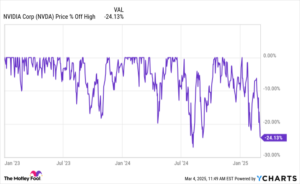Nvidia’s Rollercoaster: What Investors Should Know
Nvidia Corporation (NASDAQ: NVDA) has been at the forefront of the artificial intelligence (AI) surge, with its stock skyrocketing by more than 600% since the start of 2023. Currently boasting a staggering market capitalization of approximately $3 trillion, it has held the title of the AI chip leader. However, recent trends have shocked even the most ardent supporters of the company, raising questions about its future trajectory.
Despite beating earnings estimates and providing optimistic guidance, Nvidia’s stock recently slipped by about 16% year-to-date and saw an 8% drop following their latest earnings report. The company’s fourth-quarter results highlighted a remarkable 78% revenue growth, reaching $39.3 billion, surpassing analyst estimates of $38.2 billion. Adjusted earnings also showed commendable growth, rising from $0.49 to $0.89 per share—a significant beat, as analysts expected $0.85. Yet, investors were spooked, resulting in a decline that brought shares down 27% from their peak just a few months prior.
In a paradox that may indicate investor fatigue, Nvidia’s stock has found itself mired in ongoing concerns, including President Donald Trump’s renewed tariffs and allegations of illegal chip exports to China. These issues, coupled with the broader economic uncertainties, have created a conundrum for investors who are sitting on significant gains. Should they cash in now or hold tight as the macroeconomic landscape appears increasingly cloudy?
A Historical Context
To understand Nvidia’s current position, it is vital to look back at its recent stock history. The semiconductor sector is notoriously cyclical, and Nvidia’s ascent has been anything but smooth. Two notable past downturns reveal a consistent pattern of recovery.
The first significant drawdown occurred in 2018 when Nvidia’s stock plummeted amidst rising interest rates, heightened U.S.-China tensions, and waning demand due to a collapse in cryptocurrency mining. Though revenue took a hit, Nvidia’s stock regained its footing, returning to all-time highs within roughly a year and a half.
Fast forward to 2022, when Nvidia faced another substantial decline. The tech crash affected many companies, but Nvidia’s rapid recovery was fueled by renewed interest in AI, seeing its stock reach record levels again within the same time frame.
As it currently stands, Nvidia’s stock price has dropped significantly. Yet, this does not dampen its long-term outlook. The demand for Nvidia’s new Blackwell chips continues to outpace supply, reinforcing their competitive edge in the realm of data center graphics processing units (GPUs), critical for AI applications.
Evaluating Current Opportunities
From a valuation perspective, Nvidia appears to be trading at a forward price-to-earnings (P/E) ratio of just 25, aligning with the S&P 500’s average—despite its accelerated growth rate compared to the broader market. For those looking to optimize their investment strategies, this could represent a valuable entry point.
While Nvidia remains a stock with inherent risks, the potential for recapture of recent losses bodes well for diligent investors. Historically, Nvidia has rebounded from steeper downturns, propelled by advancements in their technology and fiscal strategies.
Conclusion: Should You Invest Now?
Before committing to an investment in Nvidia, it’s worth noting the broader landscape of stock recommendations. For instance, a leading investment advisory service has recently spotlighted a list of the "10 best stocks" for optimal future returns—overlooking Nvidia. Investors must remain informed and consider alternative opportunities as they conduct their due diligence.
In conclusion, while Nvidia’s recent sharp declines present challenges, the company’s robust position in AI and cloud computing, combined with improving valuations, warrants close watch. For those considering Nvidia or similar tech stocks, balance your portfolio with insights and strategies that align with market forecasting and your risk tolerance.
Remember, investing is not just about following trends but also understanding the underlying fundamentals that drive a company’s growth. Whether you’re eyeing Nvidia or exploring other attractive investment avenues, staying informed will empower your financial decisions.

